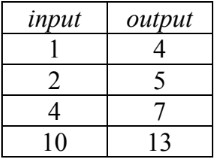Describing patterns using tables and solving variables
Topic Notes
In this lesson, we will learn:
- How to describe number patterns using a function table (input output table)
- How to write formulas with variables for function tables and solve for variables
- The steps for solving the rule (one-step and two-step) or formula for a function table
Notes:
- We can think of the relationship between numbers in a pattern as a machine
- The machine takes the number you give it (the “input”), applies a function (the “rule” or math operations), and gives you a resulting number (the “output”)

- The input output table (or function table) keeps track of these inputs and outputs
- Unlike the number sequence, order is not necessary for a function table
- Ex. for the number sequence/pattern “start at 1 and add 3 each time” it would be:

- Ex. but for the function table with a rule of “add 3” it could be:

- It is also possible to have two-step rules for function tables
- The first step is to either multiply or divide (× or ÷)
- The second step is to either add or subtract (+ or –)
- Instead of writing “input” and “output” in the function table, variables can be written instead
- Variables are symbols (letters) that represent values that can change (“varying”)
- Variables can be used to write a formula for the function table using the format:
- Or more commonly written as
- To solve for the variables in function tables:
- If solving for an output: plug the input value into the formula
- If solving for an input: plug the output value in and solve backwards (algebra)
- If you are given a complete function table and asked to solve for the formula:
- Check horizontally across input/output for one-step rules
- If it is not a one-step rule:
- If the inputs are consecutive, the multiplier m (in formula ) is the difference between outputs
- If the inputs are random, the formula can be either found by:
- (#1) trial and error
- OR (#2) using two pairs of input/output and m is the ratio of

